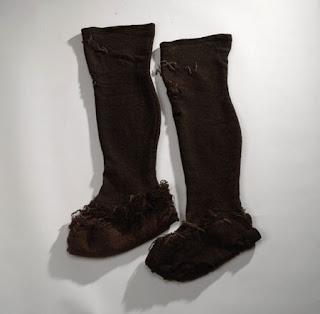Two of the most famous pieces of extant early knitwear are the Gunnister
stockings, so-called because they were found in 1951 on the
naturally-mummified body of a late-17th- or early-18th-century man in a bog in Gunnister, Shetland. Because of the anaerobic conditions of the burial, the man's clothing and possessions were remarkably well-preserved, although unlike other "bog bodies" the man's body itself was not. Among many other woolen items of clothing -- he died in wintertime -- the man wore knitted stockings, caps (two), and gloves and carried a small knitted purse. The feet of both stockings had been replaced some time before the man's death, one with a piece of fabric and the other with part of the leg of another knitted stocking.
The Gunnister man's possessions are now in the collection of the National Museums of Scotland. The NMS writes of the stockings,
This pair of woollen knitted stockings, or long socks, was discovered on a man's body found at Gunnister in Northmavine in Shetland, in the late 17th century [sic]. The stockings have been knitted in stocking stitch and include 'clocks' -- woven or embroidered ornaments on the side of socks or stockings, rising up from the ankle. When he died, the man was wearing a coat, jacket, shirt, breeches, cap and stockings. Some of his possessions were a wooden pail, a horn spoon and a knife handle which could possibly have been used for preparing and eating food.
Jacqueline Fee's re-creation of the Gunnister stockings appeared in the January/February 2011 issue of "PieceWork" magazine (with a highlights article including numerous photos in the "PieceWork" newsletter of 7 February 2022), and "recipes" for knitting similar period stockings can be found at the websites of Drea Leed and Mara Riley.


No comments:
Post a Comment